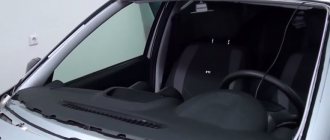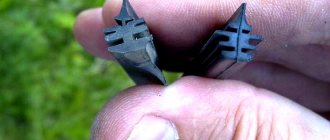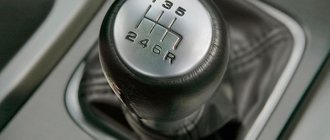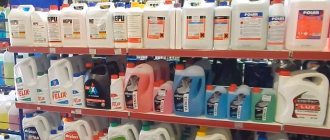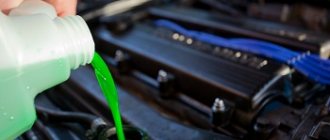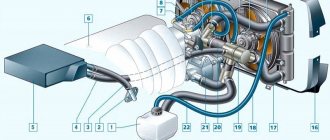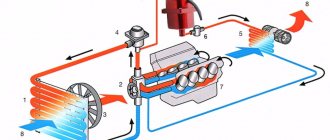What is antifreeze concentrate?
Concentrated antifreeze lacks only one component: distilled water. All other components (ethylene glycol, additives and dye) are usually present in full.
Coolant concentrates are often mistakenly confused with pure ethylene glycol. Some manufacturers indicate on the packaging that there is only ethylene glycol inside. However, this cannot be true simply because ethylene glycol is a colorless liquid. And almost all concentrates are colored according to the generally accepted class markings (G11 - green, G12 - red or yellow, etc.).
Previously, colorless coolant concentrates were commercially available. It is likely that pure ethylene glycol was used in them. However, it is not advisable to use such a concentrate to prepare a full-fledged coolant. After all, without additives, metal corrosion and destruction of rubber pipes will accelerate significantly. And these compositions were only suitable for enhancing the low-temperature properties of already filled antifreeze.
Types of antifreeze and its manufacturers
To know how to properly dilute antifreeze (concentrate) from brands such as Kostrol, Shell, Tosol-Sintez and others, you need to pay attention to the class of the liquid.
If it is G11 antifreeze, its color will be green, blue, or light green. The service life of such products does not exceed 3 years. Substances marked G12, G12-plus have red, orange, and purple colors. They do not contain silicates that cause rust formation. Their additives increase the service life of the substance up to 7 years.
Classes G11 and G12 cannot be mixed with each other. They have too different compositions. Only G12-plus antifreeze can be added to both of these types of concentrate.
The most popular manufacturers, according to consumer reviews, today are brands such as Mobil, ZIC, Shell, Tosol-Sintez, Castrol. Antifreeze (concentrate), which every car enthusiast should know how to dilute, is ideally diluted with water.
Features of concentrated antifreeze
Antifreeze should not be diluted with tap water, as it contains various impurities that can clog the engine.
The main component of antifreeze is ethylene glycol. Concentrates consist of 95–97% of this substance!, the remaining 3–5%! is distilled water and additives. This product cannot be used in its pure form.
The freezing point of a liquid depends precisely on the amount of ethylene glycol in the composition. It would be logical to assume that the higher the concentration, the lower the temperature, but this is not true. The minimum freezing point of a liquid is -68 C° and is reached when the antifreeze contains 66% ethylene glycol. If the composition is more concentrated, the freezing point increases. Thus, 95%! of the concentrate freezes already at -27 C°, and 97%! – at -22 C°.
Using undiluted product is not advisable, since the air is cooled to -68 C° only in some areas of the Arctic, and therefore, in order to save money, antifreeze can be diluted with distilled water.
Concentration selection
When deciding how to dilute antifreeze for heating systems, car engines and other systems, you should pay attention to the operating temperature of the liquid.
A regular concentrate has a freezing point of -65 degrees. In ordinary life, such conditions do not occur. Therefore, you need to do the following.
- Dilute the concentrate with distillate in a 1:1 ratio. This will increase the crystallization temperature to -40 degrees. This is quite enough even for harsh winters.
- If you take 2 liters of antifreeze and 3 liters of water, the freezing point will increase to -30 degrees.
- A proportion of 1:2 will give a liquid with a crystallization limit of -20 degrees. Depending on the climatic latitude, you should choose one of three methods.
The concentrate should not be diluted too much. This will reduce the influence of additives and deteriorate the quality of the fluid.
Properties and characteristics of the solution
The main purpose of antifreeze is to cool the unit. The temperature from the combustion of hydrocarbon fuel exceeds 2,100 °C. Therefore, the power unit requires intensive cooling to prevent premature failure of its parts.
When operating in winter, it is necessary that the coolant does not crystallize. When frozen, it can damage and destroy rubber and plastic parts.
The main components of antifreeze liquids are:
- distilled water;
- ethylene glycol;
- anti-corrosion additives;
- dye.
Additionally, we recommend reading the article, which describes in detail what is better - antifreeze or antifreeze.
Read about how to make an antifreeze with your own hands from available ingredients in the informative article by our specialist.
If everything is clear with ready-made solutions, then you should deal with concentrated formulations. In order for antifreeze to remain in a liquid state all year round, it is necessary to properly dilute the concentrated composition, and for this you should remember the following features:
- engine operating temperature 90 - 110 °C;
- winter air temperature is no more than -40 °C.
The maximum concentration of ethylene glycol, a diatomic alcohol, increases the boiling point to +200 °C. But at the same time, its freezing threshold is -13°C. If this is not critical for summer, then it is unacceptable for winter.
To achieve the required properties of the coolant, you need to properly dilute the antifreeze concentrate in accordance with the instructions on the package.
The need to dilute antifreeze
There are two types of antifreeze available on sale. This can be a concentrate, or a ready-to-use substance. The need to dilute antifreeze with water lies in its full cooling properties.
If the refrigerant is used in the hot season, the water from the mixture will evaporate faster, leaving the same concentrate inside the system. The ethylene glycol included in its composition will negatively affect the system parts.
Fuel combustion in the engine occurs at temperatures above 2100 degrees. Without forced cooling, the parts would become so hot that they would exceed the oil's ignition temperature threshold. All contacting surfaces would wear out extremely quickly.
However, the question of how to dilute antifreeze (concentrate) must be resolved in accordance with the manufacturer's instructions. Too much cooling can also harm the system. Therefore, it is necessary to maintain a thermal regime of 85-95 degrees.
For heating systems it is also important not to exceed the vaporization limits. Therefore, the upper temperature limit for such substances is also set at 95 degrees.
What should the density of antifreeze be?
After you have received all the necessary fluid indicators, you need to compare them with the indicators from the table. If the concentration of ethylene glycol is 85.4%!, and the crystallization temperature is -40 degrees, then the density of the mixture must be at least 1.104 g/cm3. By analogy, you can determine any value and find out at what density a particular freezing threshold of the composition will be.
For convenience, we present the normal density indicators for the most popular antifreezes:
- the density of Liqui Moly KFC liquid is 1.113 g/cm3;
- for Toras antifreeze OZH40 this figure is 1.087 g/cm3;
- Castrol Radiocool has a density value of 1.122 g/cm3;
- Mobil Antifreeze Advanced density ranges from 1.122 to 1.125 g/cm3;
- for Mannol Longlife AF12+ the standard value is 1.085 g/cm3.
Many antifreezes are made with a reserve, that is, their freezing point can be up to -60 degrees. We don’t have such cold Arctic winters, so such “coolers” can be diluted with water without a twinge of conscience in order to achieve the crystallization threshold of the composition at -35 degrees.
What to use for dilution
Everyone decides for themselves whether to use a concentrate or a ready-made composition. The convenience of its use speaks in favor of the second option. Be sure to keep a canister of coolant in your car. Deficiency, contamination and simply loss of your coolant can be one of the reasons for engine overheating. The consequences may be unpredictable, but certainly expensive to eliminate.
We recommend: Fixing the problem with low beam lamps on the Lada Kalina
If you choose a concentrate, be sure to decide on the manufacturer and its type. There are compositions marked G11, G12, G13, the composition can be green or red. In order not to repeat myself, I suggest you read our material on mixing antifreeze, where you will get answers to all your questions. In the meantime, let's talk about an equally significant point, which concerns the preparation of finished cooling liquid based on a concentrated composition. After all, so much has already been said about dilution, but no one has yet answered with what exactly needs to be diluted.
Antifreeze is a liquid that simultaneously prevents the engine from overheating, cooling it, and keeps it clean, protects it from additives, rust, sediment and other types of contaminants, including corrosion.
Some people dilute the concentrate with tap water. This is absolutely wrong, since such water contains chlorine, magnesium, calcium and other components that are dangerous to water. They clog the internal channels of the cooling system, reduce its efficiency, provoke rust formation, etc.
The concentrate can only be diluted with purified distilled water.
The peculiarity of this water is the absence of harmful impurities. Just don't run to the pharmacy for it. Car dealerships sell cans of various sizes for little money. My wife suggests that it is useful to use the same water for irons, as it prevents the formation of scale.
Consistency - mushy
Now Evgeniy Ryazanov suggests taking samples out of the heat chamber and using a chemical stick to check their condition.
With unfrozen samples, everything is clear - they are in a liquid state, so they are of no interest to us. But the “well-being” of the samples that did not pass the test is more interesting.
“The consistency is snow-like,” the specialist picks up the flask with sample No. 10.
The situation is similar with samples No. 8 and 9. This is a thick paste. The same shit.
— In sample No. 4, crystals are partially visible. And No. 1 and 2 froze more densely and are a snowy, loose mush.
In fact, this means that they still contain some ethylene glycol (propylene glycol) and do not pose a danger in terms of mechanical destruction of the cooling system and engine elements.
How to dilute antifreeze?
To begin with, keep in mind that the coolant not only cools the engine, but also prevents corrosion and increases its wear resistance, extending its service life with the help of additives. Therefore, if you dilute it with tap water, there is a high risk of not only reducing all the properties of the liquid to nothing, but also further accelerating the rusting of the internal components of the engine. Please note that tap water contains the following components:
- calcium;
- chlorine;
- magnesium, etc.
They are used for cleaning, but quickly clog the small channels of the motor, reducing its efficiency.
All that remains is the distillate, and it is pure . It is purchased in automobile or hardware stores in unlimited quantities. Although some craftsmen manage to assemble it themselves. Fortunately, there are plenty of ways.
How is antifreeze better than water?
But the evolution of coolants did not end there. The chemical elements that make up antifreeze prepared a whole bunch of troubles and problems that technologists had to overcome until the result was an effective liquid that meets all the requirements of modern engines. What might the requirements be? The main thing is that the liquid removes heat from the engine and does not freeze in winter. Everything is true, but there are a few nuances that you need to know before diluting antifreeze concentrate.
The cooling system of a more or less modern engine is not as simple as it might seem. Even in VAZ cars developed in the 60s of the last century, a special antifreeze of a certain composition had to be used. This is due to the fact that the substances that make up antifreeze can react aggressively to engine parts, water pump, thermostat, heater radiators and the main cooling radiator. Antifreeze contains ethylene glycol, several special additives and distilled water.
Antifreeze boiling
In addition to its cooling effect, the liquid can prevent too much vaporization. Here it is also very important to read the instructions on how to dilute antifreeze correctly.
If the system overheats, its further operation will be impossible. It is quite possible that even after cooling, its elements will not be able to work correctly due to serious damage. Therefore, to prevent such situations, you should also understand how to properly dilute antifreeze for the engine or heating system.
Breeding rules
For dilution, use distilled water, sold in automotive or hardware stores. Using tap, well or spring water is fraught with trouble. Microelements contained in water quickly settle on the walls of the unit, which leads to a decrease in the cooling effect.
This is interesting: How to choose durable winter tires for your car? 3 main selection criteria
If a manufacturer claims that its products can be diluted with tap water, then a small experiment is conducted to check. Liquid, tap water and solution are poured into a transparent container. The result is checked after two days. If the solution is cloudy or there is sediment at the bottom, then this composition must be diluted with distillate.
If antifreeze is used in heating systems, then its main quality is resistance to boiling over. To prevent the liquid from crossing the vaporization threshold, the antifreeze concentrate must be diluted at a maximum temperature of 95 ° C.
If the proportions are not met, then ethylene glycol will undergo intense evaporation, not water. As a result, the entire coolant will have to be replaced.
In what proportion should water and concentrated liquid be mixed? For example, if you take them one part at a time, the freezing threshold of such a solution is -45 °C, and boiling occurs in the range of 130 - 140 °C.
The table of proportions clearly shows the dilution of antifreeze concentrate.
| Solution concentration, %! | Proportion | Crystallization limit, °C | Vaporization limit, °C |
| concentrate – water | |||
| 13 — 87 | -7 | +100 | |
| 25 — 75 | 1:3 | -15 | +100 |
| 50 — 50 | 1:1 | -45 | +135 |
| 60 — 40 | 3:2 | -60 | +155 |
| 75 — 25 | 3:1 | -70 | +170 |
The table displays the manufacturers' requirements for diluting antifreeze concentrate. With increased water content, properties are lost.
Well-known brands of antifreeze concentrate
There are a dozen and a half manufacturers of high-quality antifreeze concentrate
The choice of brand of antifreeze concentrate must be made taking into account the specific conditions of its use.
- Antifreeze GM dex cool longlife, concentrate. Has high anti-corrosion properties. Does not form sediment.
- Antifreeze G12, concentrate. Endurance in hard water. Favorable effect on rubber at t +100°C. Suitable for older machines, extending their service life.
- Mobil antifreeze, concentrate. High anti-corrosion properties. Used in cast iron and aluminum motors. Resistant to freezing even in extreme frosts.
- Shell antifreeze, concentrate. Designed for operation of diesel and gasoline engines. Contains anti-corrosion additives. Meets the requirements of international standards.
- Hepu antifreeze, concentrate. Manufactured using the latest cutting-edge technologies from high-quality raw materials. This allows him to guarantee the most necessary properties. Eliminates the formation of steam and bubble condensation.
- Febi is an antifreeze concentrate. This is unusually strong protection against freezing, corrosion and cavitation. Eliminates the formation of sediment. Protects rubber pipes and gaskets of the system.
- Total antifreeze, concentrate. Suitable for all types of vehicles. It is of high quality and does not allow rust. It contains no amines, nitrites or phosphates. Suitable for all engines. Most often used on MAN, MTU and Mercedes power units.
- Antifreeze Crown llc A 110, concentrate. Cools the engine perfectly. Has excellent protective properties against corrosion and cavitation. Pump pipes and seals are not exposed to aggressive influences. Foaming and scale formation are not allowed. No carcinogenic compounds are formed.
- Antifreeze Kuhlerfrostschutz kfs 2001 plus G12, concentrate. Eliminates overheating and freezing of the cooling system. Has excellent anti-corrosion properties. Designed for high-load aluminum engines. Meets the standards of leading automotive manufacturers. Keeps coolant pump seals operational. The operation of cars and motorcycles with this liquid is possible in different temperature conditions.
- Motul antifreeze, concentrate. Has the ability to protect metal parts from corrosion. Has good heat transfer. Effectively promotes engine cooling, preventing boiling. At high temperatures it has anti-corrosion effects. Ensures good operation of the water pump while preventing cavitation. Not aggressive to metal or plastic. Protects rubber products.
- Antifreeze Sintek, concentrate. Used for good performance of modern engines with heavy loads. Protecting the cooling system, it prevents deposits in engine mechanisms. It has lubricating properties that prolong the operation of water pumps. Does not cause damage to hoses, gaskets and seals of the cooling system. There are no nitrites or amines in this coolant.
- Liqui Moly antifreeze concentrate. It has a high boiling point, low freezing point, and high thermal conductivity. Has a non-aggressive effect on the cooling system. Has good chemical stability. There were no cases of chemical exposure to rubber components. Contains anti-corrosion, lubricating and anti-foam additives.
We recommend: Replacing valve guides on VAZ 2106 and 2109 cars
Coolant properties
Antifreeze is used not only for cars, but also for heating systems and aircraft engines. The liquid contains ethylene glycol and various additives
. They will improve not only the operation of the units, but also prevent their rapid wear. If the concentrate is diluted correctly, the coolant will provide the following conditions for the engine:
- the boiling point will be low or optimal;
- the service life will be long and without loss;
- rubber products will get rid of the aggressive influence on them;
- the boiling point will be high and the thermal conductivity will be high;
- anti-foam characteristics will be high.
Breeding technology and proportions
First, let's figure out exactly how to mix the concentrate with water so that you don't have to pour out the resulting composition later.
- The sequence of what to pour into does not matter. As well as the container in which mixing will take place. It is important to simply maintain the proportions.
- In some cases, pouring water into the expansion tank first, and then concentrate, is possible, but not advisable. Firstly, if you are preparing antifreeze immediately for a complete replacement, then the amount you calculated may not be enough. Or, conversely, you will end up with too much antifreeze. For example, you first poured 3 liters of concentrate, and then planned to add 3 liters of water. Since they knew that the total volume of coolant in the system is 6 liters. However, 3 liters of concentrate fit in without any problems, but only 2.5 liters of water went in. Because there was still old antifreeze in the system, or there was a non-standard radiator, or there was some other reason. And in winter, at temperatures below –13 °C, pouring liquids separately is strictly prohibited. Paradoxical but true: pure ethylene glycol (like antifreeze concentrate) freezes at a temperature of –13 °C.
- You cannot add concentrate from one coolant to another. There are known cases when, during such mixing, some of the additives conflicted and precipitated.
There are three most common proportions for mixing coolants:
- 1 to 1 – the output is antifreeze with a freezing point of approximately –35 °C;
- 40%!concentrate, 60%!water – you get a coolant that will not freeze to approximately –25 °C;
- 60%!concentrate, 40%!water – antifreeze that will withstand temperatures down to –55 °C.
To create antifreezes with other freezing points, there is a table below that shows a wider range of possible mixtures.
| Concentrate content in the mixture, %! | Antifreeze freezing point, °C |
| 100 | –12 |
| 95 | –22 |
| 90 | –29 |
| 80 | –48 |
| 75 | –58 |
| 67 | –75 |
| 60 | –55 |
| 55 | –42 |
| 50 | –34 |
| 40 | –24 |
| 30 | –15 |
We recommend: Nissan Quasqai: replacing low beam lamps
For the middle zone, antifreeze with an indicator of - 25 C° will be sufficient, for the northern regions at least - 40 C°
Certified packages of concentrated antifreeze will necessarily indicate the proportions in which the liquid should be diluted so that it meets the required parameters.
In order for the product to withstand temperatures of -25 C°, the concentrate is diluted with distilled water in a ratio of 2:3. To achieve a freezing threshold of -45 C°, the liquid is diluted in equal proportions.
Table: antifreeze concentration depending on temperature
Ethylene glycol itself freezes at a temperature of -13 C°
Concentrated antifreeze can be diluted in accordance with the temperature conditions of a particular region. Ready-made liquids, as a rule, can withstand extreme frosts, but are much more expensive. By correctly selecting the parameters of the antifreeze fluid, you will increase the service life of your car’s engine.
What antifreeze to fill in Ford Focus 2: survey
To decide what antifreeze to pour into Ford Focus 2 for replacement or topping up, you need to not just remember the appearance of the can and the color of the liquid.
As a rule, the color of antifreeze does not in any way indicate its composition, and liquid manufacturers can write whatever they want on the packaging.
It is important to pour exactly the antifreeze composition that does not contradict the factory recommendations and will not lead to corrosion of the cylinder block, rapid wear of the pump or coking of the radiator.
What is poured from the factory into Focus 2 radiators?
In all Ford cars, including Focus 2, which are produced in Europe and the Russian Federation, Havoline XLC carboxylate liquid is poured into the cooling system on a conveyor belt.
Initially, it is painted orange, and the abbreviation on the label means that it is a coolant with an extended service life ( Extended Life Anti-Freeze Coolant ).
This is a Belgian liquid produced by Arteco, a joint venture between the American Chevron and the French Total.
Such liquids are also found under the Chevron brand, but they can be produced both in Russia and in Finland, China, Spain and India.
Warning about the dangers of antifreeze on the back of the original packaging.
The liquid sold by official dealers, Ford SUPER PLUS Premium, is Havoline XLC antifreeze.
According to Ford catalogs, it goes under the number WSS-М97В44-D (this number is also a Ford specification at the same time.
Antifreezes distributed by officials are painted purple, but in composition and characteristics these liquids are absolutely identical. This means that you can safely add and dilute Ford Super Plus to Havoline conveyor antifreeze in any proportions.
How to replace the expensive Ford SUPER PLUS Premium
Original expensive antifreeze for Focus 2.
A liter of Ford concentrate costs about 350 rubles .
It is diluted in a 50/50 ratio with demineralized (distilled) water , and until 2011, only Belgian components were imported to the plant in Vsevolozhsk, and they were only diluted on the assembly line.
Antifreeze remained fluid down to -37 degrees and boiled at temperatures from +110 degrees. Several years ago in Klimovsk they launched the production of domestic antifreeze from components from Arteco and called it CoolStream Premium.
Analogs
Non-original antifreeze replacement kit (concentrate and distilled water)
At the same time, antifreeze turned out to be almost half the price of branded Ford antifreeze and is always available for free sale. They sell both CoolStream Premium C concentrate and ready-made antifreeze CoolStream Premium 40 and CoolStream Premium 65, depending on the proportions of water and concentrate. All these three brands of antifreeze are exactly the same in composition, the only difference can be in color.
What color should antifreeze be for Focus 2?
Drained antifreeze when replacing it.
Any coolant is colorless by nature. The dye is added only after the completion of the material preparation process in an amount of about several grams per thousand liters. Therefore, the color of different manufacturers can be anything from light green to bright blue. Why such color complications? Manufacturers explain it this way:
- by color you can roughly determine the brand of antifreeze;
- the car manufacturer requires a certain color, for example, Ford wants orange, Volvo yellow, and Volkswagen only purple, although the liquids can be completely identical in composition and properties;
- if the antifreeze is colored, then it is easier to see the level in the expansion tank, and also to calculate the location of the leak;
- You can check whether the antifreeze was replaced during operation.
Therefore, color when choosing antifreeze to replace or top up is absolutely not an indicator if the Ford standard WSS-M97B44-D or Ford recommendation is not indicated on the packaging.
What should I add?
Here is an approximate list of liquids of various colors that can be safely poured and added to the Ford Focus 2 cooling system:
Antifreeze brand Color
| ACDelco DexCool Longlife | orange |
| BP ProCool | orange |
| Caltex Extended Life Coolant | orange |
| Chevron Delo ELC | orange |
| Fuchs MAINTAIN FRICOFIN LL | orange |
| G-Energy Antifreeze SNF | orange |
| GlasElf Auto Supra | red |
| GM Longlife | pink |
| Polar Premium Longlife Antifreeze | red |
| Volvo Coolant VCS | yellow |
| Texaco XLC DexCool | orange |
| Motorcraft®Specialty Orange Engine Coolant | orange |
All these antifreezes are of the carboxylate type and have an identical composition. In addition to the brands listed above, other liquid compositions are also suitable for a complete replacement, but only of the carboxylate type. Keep an eye on the antifreeze temperature and have a nice trip everyone!
Source: https://carfrance.ru/kakoj-antifriz-zalivat-v-ford-focus-2/
Why dilute antifreeze concentrate?
To understand how and why to dilute the liquid before pouring the composition into the tank, you need to understand its chemical composition and the functions that the cooler performs. The main purpose of antifreeze is to keep the operating temperature of the engine at 90-110 degrees Celsius.
It is strictly not recommended to exceed the permissible limit, otherwise the engine will simply overheat, which is fraught with expensive capital and smaller problems.
Based on this, one conclusion suggests itself: the coolant must be liquid all year round in order to move freely through the radiator tubes, contributing to the systematic and timely cooling of the hottest engine blocks. Ordinary water, like concentrate, is absolutely not suitable for this task:
- water (ordinary or distilled) does not withstand the tests of heat and cold, since it boils at 100 degrees (standard engine temperature under load) and freezes at 0 (turning into ice and bursting the radiator from the inside);
- concentrated antifreeze consists of ethylene glycol (dihydric alcohol), which perfectly withstands hot temperatures thanks to its boiling point of 200 degrees, but is completely useless in the cold with its freezing point of -13 degrees Celsius. Add to this the harsh Russian winter conditions and the picture becomes clear.
Does ethylene glycol need to be diluted? Definitely. It mixes well with both water and other alcohols, acquiring new properties. Thanks to this, it is possible to lower the freezing threshold down to -70 degrees . Yes, the heat resistance threshold decreases, but not to a critical level.
Two samples both “burn” and “freeze”
Last time we heated antifreeze to find out the boiling point. And to make it even more convincing, they set fire to the steam. All of these coolants were also subjected to a freeze test. So here are two samples that both “burn” and “freeze”!
“This is another evidence that these antifreezes are of poor quality,” emphasizes Evgeny Ryazanov. — Moreover, it is incorrect to call these liquids antifreeze.
According to experts, the fact of freezing indicates that the coolant contains an insufficient amount of the base component (ethylene glycol). For example, it could be replaced with methanol to reduce the cost.
“A lot was said about methanol last time,” recalls the head of the technical development department at Shate-M Plus. — Methyl alcohol forms flammable vapors and activates corrosion. As methanol boils away, the temperature at which crystallization begins will increase. In the worst case, such a liquid in severe frost will turn not into mush, but into monolithic ice, which is fraught with mechanical destruction of the elements of the cooling system.
Which antifreeze concentrate is better?
Antifreeze concentrate is available in several colors
Different colors of concentrates exist to differentiate product classes, brands and their compatibility.
Coolant is essential for good engine performance. Otherwise the motor may be damaged. The coolant contains reagents that do not freeze. Among other things, antifreeze comes in various colors: green, red, blue, etc. The colors are obtained due to the non-food dyes present in the liquid. Different colors exist to differentiate product classes and their brands. And also their compatibility. Remember what color you filled in , and next time take the appropriate color. Color compatibility is indicated on the label. Antifreeze concentrate is green . In addition to the dye, its composition includes a fairly large number of various additives. They prevent corrosion and destruction of engine and radiator surfaces. Allows the entire system to operate better at different temperatures and in different climatic zones. Typically, the freezing point of antifreeze concentrate can be from -40 to +50 degrees. But each manufacturer may have its own nuances. Antifreeze concentrate is red . Before use, dilution should be done with distilled water. If the manufacturer assures that it can be diluted with tap water, then it is better to make a little mixture for testing. In a few days it will be clear whether precipitation has fallen or not. Various additives added to this coolant help improve the performance of the cooling system. For a temperature of -40°C, the concentrate must be diluted in a ratio of 1:1. At t -30°C in a ratio of 2:3, at t -20°C in a ratio of 1:2. Antifreeze concentrate blue . It has excellent anti-corrosion properties and a long service life. This coolant is designed for both diesel and gasoline engines. It should be diluted with distilled water in a ratio of 1:1, which makes it possible to work at a temperature of -35°C. A little advice: to avoid purchasing fakes and counterfeits, it is recommended to buy coolant concentrate in specialized stores. Always pay special attention to the manufacturer's brand. Here are several manufacturing companies that produce high-quality products that contain additives that prevent the formation of steam moisture in the system:
- Lukoil;
- Hepu;
- Febi;
- Sintek, which belongs to the Obninskorgsintez concern;
- Felix;
- AWM.
The price of antifreeze concentrate depends on the manufacturer, the region of sale, the quality and volume. We must remember that quality goods are always more expensive. You should not skimp on quality; in any case, it will not be profitable, since you can lose a lot of money on expensive repairs.
- Antifreeze plays an important role in the operation of essential vehicle systems.
- Incorrect proportions when diluting the refrigerant with water can cause serious damage to parts and disrupt the integrity of the overall operational system of the internal combustion engine.
- To dilute the concentrate, only distilled water is used, since it does not leave suspensions or sediments, which over time can cause blocking of engine parts and working units.
Description of Ford Super Plus Premium antifreeze
Super Plus Premium coolant is designed for use in Ford vehicles. Suitable for diesel and gasoline engines. It is also poured into these vehicles at factories. Externally it is a transparent, slightly colored liquid.
This refrigerant is produced using organic acid technology - that is, it is carboxylate. The composition does not contain harmful substances such as nitrites and nitrates, borates. Also, silicates are not used in the production of the liquid.
This fluid has a very long service life - replacement is carried out after 10 years, which is not so common with other carboxylate products.
During operation, it will evaporate, and a small amount of distilled water can be poured into the tank or mixed with a similar antifreeze.
Antifreeze for Ford is a concentrated liquid. This means that the substance cannot be used in its pure form, as it will be harmful to the engine.
Before use, it must be mixed with distilled water in accordance with the manufacturer’s recommendations (how to dilute is written in the instructions).
With a 1:1 ratio of water and concentrate, the liquid will protect the internal combustion engine from freezing down to a temperature of minus 37 degrees Celsius.
Important! Only dilute with distilled, soft and clean water! Hard ones will harm the antifreeze and the engine.
The chemical composition of Ford coolant determines its characteristics.
Thus, due to the absence of harmful substances, the risk of deposits occurring inside is reduced, which has a positive effect on thermal conductivity and protects the pump, radiator, cylinder block, water pump and other system elements from contamination. Also, this composition is considered more environmentally friendly and safer for the environment than the classic one.
The peculiarity of carboxylate liquid is not only that it needs to be changed less often than silicate liquid. She acts differently.
Since corrosion often occurs in the cooling system, which leads to deterioration of its performance and breakdowns, corrosion inhibitors must be added to the coolant.
In carboxylate, they act directionally, accumulating in those places where the process of destruction of the metal begins, stopping it.
In addition, Ford Super Plus Premium antifreeze has good anti-foam, lubricating and heat-dissipating properties, protecting the engine not only from freezing, but also from overheating.
In addition, it prevents the harmful development of cavitation. As a result of this process, air bubbles form and collapse in the area of the sleeves, destroying the metal.
The anti-cavitation properties of antifreeze reduce this process.
The liquid is light purple in color. The dye does not affect the properties of antifreeze in any way and is added for several purposes. Firstly, it helps to distinguish coolant from water and one antifreeze from another.
Secondly, this will make it easier to monitor the fluid level in the tank and detect leaks in time.
The color of antifreeze is in no way related to the standard and technology of its production, so you should not rely on it when mixing different brands. Complies with G12 standard.
Article number of antifreeze with a capacity of 1 liter - FORD 1 336 797, 5 liters - FORD 1 675 746.
Rebrands and analogues
The original Super Plus Premium antifreeze has a high price, so after the end of its service life the question arises of what to replace it with.
If topping up in small quantities is required, the manufacturer recommends doing this with ordinary distilled water.
After all, it is this that first evaporates during operation, and not the salts and alcohols of antifreeze. At the same time, the quality of the coolant will not change in any way.
If you need to top up antifreeze in a volume greater than 100-200 ml, or completely replace it, then it is not necessary to buy what was filled in at the factory. Different companies produce Ford antifreeze under different names (that is, rebrands) and at a more favorable price. The most common:
Havoline XLC. European antifreeze, orange in color, is poured at some European and Russian factories.
CoolStream Premium. Antifreeze of domestic production, orange. It is produced not only in the form of a concentrate, but also as a ready-to-use liquid. It is poured into Ford cars at Russian factories.
Lukoil Antifreeze ultra G12. Popular Russian antifreeze, orange.
Motorcraft®Specialty Orange Engine Coolant. American coolant. Not to be confused with other Motorcraft Coolants. Orange color.
GM Longlife according to specification 6277M. Popular antifreeze, pink color.
Volvo Coolant VCS. Original Volvo antifreeze, yellow.
GlasElf Auto Supra. Available in the form of a concentrate and a finished liquid, red in color.
ZERO Long Life. Antifreeze made in Estonia, red color.
All of them are the same antifreeze, produced in different countries and at different factories and packaged in different containers. In our country, the most common and accessible coolants are Havolin, Coolstream, and Lukoil.
What’s noteworthy is that the color of the original Super plus premium is light purple, while most of its rebrands are orange or red. This is the personal desire of the manufacturer and should not confuse the motorist. The added dye does not affect the properties of the coolant in any way, so the above liquids can be safely mixed.
If it is not possible to buy original or rebranded antifreeze, then any analogue - carboxylate liquid with Ford approval - will be suitable for replacing or topping up our coolant. For example:
Important! If you add the recommended rebrand to the original, this will not affect the properties of the antifreeze in any way. If you interfere with an analogue, the service life will decrease, and some qualities may also deteriorate.
How to spot a fake
Most often, Super plus premium antifreeze is filled in at the factory. That is, when buying a new car, there should be no doubt about the authenticity of its antifreeze.
When purchasing a car secondhand, if the former owner claims that the antifreeze was not changed, you should check its color. If Ford original antifreeze was filled into the tank at the factory, its color is purple.
If Havolin or Coolstream is there, it’s orange. Liquid of other colors will indicate deception.
When buying an original in a canister, you just need to pay attention to its quality in order to distinguish it from a fake. The canister is black, opaque, the lid is ribbed, tightly connected to the protective ring. The label briefly outlines the basic information: composition, address of the manufacturer, article number, recommendations for use and storage, mention of the harmfulness of the substance.
What Ford oil, choice of wheel bearing, what antifreeze. FAQ 13-2
Arseniy, 32 years old I believe that it is always better to use antifreeze recommended by the manufacturer. That's why I only put Super plus premium coolant into my Ford. It's very high quality. I dilute with water as recommended. I drive calmly until severe frosts. I also like that it is environmentally friendly - made from organic acids and without harmful substances.


